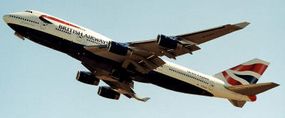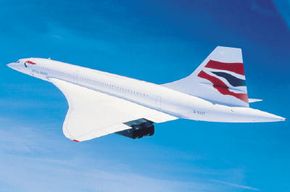Streamlined Design
As any aircraft approaches the speed of sound (1100 ft/s, 343 m/s), the air pressure builds up in front of the aircraft, forming a "wall" of air. To punch through that wall of air, planes must be streamlined. To streamline the Concorde, the following designs had to be implemented:
- Needle-like fuselage
- Swept-back delta wing
- Moveable nose
- Vertical tail design
The fuselage (body) of the Concorde was only 9.5 ft (2.7 m) wide (for comparison, a 747 is 20 ft (6.1 m) wide). The length of the Concorde was about 202 ft (61.7 m), just slightly shorter than a 747. The long, narrow shape of the Concorde reduced the drag on the plane as it moves through the air.
Advertisement

The wing of the Concorde was thin, swept back and triangular, whereas a 747's wing is swept back but rectangular. Also, there was no space between the fuselage and the wing of the Concorde as there is in the 747. The Concorde's wing was called a delta-wing design and did the following:
- Reduces drag by being thin and swept back (55 degrees with the fuselage)
- Provides sufficient lift for takeoff and landing at subsonic speeds
- Provides stability in flight so that no horizontal stabilizers are needed on the tail
The Concorde had a longer, needle-shaped nose compared to most commercial jets. The nose helped penetrate the air, and can be tilted down upon takeoff and landing (13 degrees) so that the pilots can see the runway. (Delta-winged aircraft have a steeper angle of attack during takeoff and landing than other types of aircraft.) Also, the Concorde's nose had a visor to protect the windshield when flying at supersonic speeds.
As mentioned above, because the delta wing provided stability to the aircraft, the Concorde did not require a horizontal stabilizer on the tail like most other aircraft.
These designs in the body and wings of the aircraft allowed it to move easily through the air at high speed.
